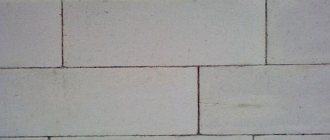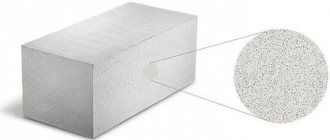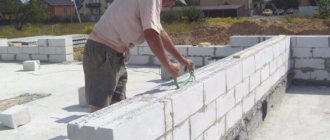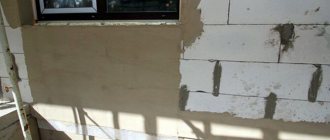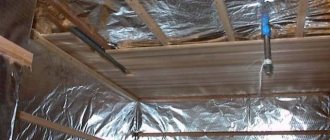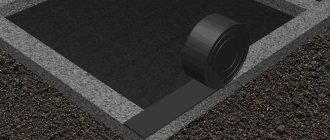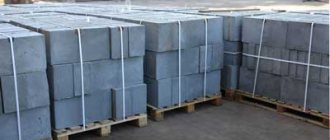Aerated concrete block products differ from conventional concrete in their low thermal conductivity. This quality is achieved by the presence of aluminum powder in the feedstock. Hydrogen bubbles spread throughout the hardening mass, which allows aerated concrete to transfer less heat than concrete. But this advantage is fraught with a decrease in strength, which is relevant when comparing blocks with concrete analogues. Based on this, the thickness of aerated concrete walls is determined taking into account the required level of thermal insulation and structural strength. And here there is another important feature - full compliance with the existing budget.
Load-bearing wall thickness
The construction of any object is preceded by strength calculations. It is not always possible to perform such actions on your own; for this reason, it is allowed to use parameters that determine strength.
The thickness of the load-bearing wall is determined taking into account these data.
Another important factor is the purpose of the facility being built. If the house is low-rise and is intended to be used during the summer season, it is recommended to comply with a number of simple requirements:
- when constructing a one-story building in an area with a warm climate, a garage and other outbuildings, aerated concrete 250 mm thick is used;
- for two- or three-story buildings this parameter increases to 300 mm;
- when constructing basements or ground floors, the recommended wall thickness is from 30 to 40 cm. But remember that aerated concrete is afraid of abundant moisture, so it is necessary to use other materials.
If the construction of a facility intended for year-round living is meant, the strength indicator is not enough. In this case, the thermal conductivity of the material is taken into account. Using calculations, the minimum thickness of an aerated concrete wall is determined, or the same parameters remain as for summer houses, but the external walls are additionally insulated. In this case, the calculation is carried out according to the available money - a more profitable option is determined. Either the thickness of the load-bearing aerated concrete wall is increased, or insulation is used.
When determining the cost of insulation material, do not forget about fasteners and the cost of specialist services.
Weight of 1 m3 of aerated block, formula for calculation, characteristics, price per cubic meter
- Weight of aerated concrete
- Calculation example
- Price
Weight of blocks of different sizes
According to their purpose, gas silicate blocks are divided into:
A practical option for a 1-floor residential building would be the D500-D600 brand. Dimensions also affect weight, so blocks measuring 600x300x200 mm will weigh more than 300x100x100, provided they have the same density.
Typical calculation of the mass of aerated concrete
The weight is determined using the example of a block 600x250x400 mm. The formula for calculation is as follows: density (kg/m3) x volume (m3) = mass (kg).
This method can be used for any size of gas blocks of different densities. However, it is important to consider the load that will affect the foundation.
Thickness of partition walls
This parameter is selected taking into account certain factors, the load-bearing capacity is calculated and the height of the partition is taken into account.
When choosing blocks for such walls, you should pay close attention to the height value:
- if it does not exceed the three-meter mark, then the optimal wall thickness is 10 cm;
- when the height increases to five meters, it is recommended to use blocks whose thickness is 20 cm.
If there is a need to obtain accurate information without performing calculations, you can use standard values, which take into account connections with the upper floors and the lengths of the walls being erected. Particular attention is paid to the following tips:
- when determining the operational load on the internal wall, it becomes possible to select optimal materials;
- for load-bearing partitions, it is recommended to use D 500 or D 600 blocks, the length of which reaches 62.5 cm, the width varies from 7.5 to 20 cm;
- the installation of conventional partitions involves the use of blocks with a density index of D 350 - 400, which makes it possible to improve standard sound insulation parameters;
- The sound insulation indicator fully depends on the thickness of the block and its density. The higher it is, the better soundproofing properties the material has.
If the length of the partition is eight meters or more, and its height is four meters or more, then in order to increase the strength of the entire structure, the frame base is reinforced with a reinforced concrete reinforcing belt. In addition, the required strength of the partition can be achieved by using the adhesive composition used for laying.
Factors reducing energy efficiency
When calculating the thickness of a wall built from aerated concrete blocks for a house or other object, we are talking about a solid aerated block. In practice, during the construction of a building, individual elements are used, which are connected to each other with concrete or mortar joints. This results in a large number of joints—possible “cold bridges.” In addition, reinforcement is placed in the wall structure and a reinforcing belt is formed - this leads to an increase in thermal conductivity.
To maintain the high insulating characteristics of aerated concrete masonry, you must adhere to the following rules:
- Bonding solutions must be prepared from dry adhesive compositions designed specifically for aerated concrete. Such mixtures consist of cement, mineral components and polymer modifying additives. If work is carried out in winter, the mixture must contain antifreeze additives. To minimize heat loss, it is recommended to make a layer of adhesive seam 2–3 mm thick. If, in an attempt to save money, you replace the special composition with a solution of cement and sand, the results will not be the most pleasant: the size of the seam will increase, which will lead to problems with “cold bridges”.
- Up to 25% of heat escapes through the walls. The bulk of heat loss is associated with windows, roof and foundation. Therefore, these problem areas require special attention and careful thermal insulation.
- In settlements with a cold climate, it is advisable to insulate the walls from the outside.
Wall thickness for different regions
The optimal option for designing an object is complete calculations of strength and thermal conductivity, but not every person is capable of such a task. And there is no desire to pay money for the services provided. In such cases, you should focus on the approximate strength and thickness of aerated concrete blocks for external walls.
Compared to other materials, aerated concrete has a significantly smaller thickness with the same energy efficiency.
Such advice is considered to be recommendations of an average nature, compiled mainly on the basis of statistical data on the use of aerated concrete material in the construction industry and recommendations of manufacturers.
If construction is to be done in a region with warm climatic conditions, then the thickness of the walls should be from 20 cm. But the value is advisory, and many developers opt for 30 cm.
What thickness should be the walls of objects being built in other regions of Russia? Here everything depends on the average daily temperature. For example, for Siberia, the thickness of an aerated concrete wall should be greater than in the southern regions.
Aerated concrete in your city
The block is aerated concrete. Gas block. Aerated concrete. Gas silicate.
More Articles on this topic:
⇒ What is good about aerated concrete. Pros and cons ⇒ Laying walls from aerated concrete and gas silicate blocks ⇒ Interior decoration of house walls from aerated concrete, gas silicate ⇒ Exterior decoration of house walls from aerated concrete, gas silicate blocks
More articles on this topic
- Large-porous expanded clay concrete - material for building walls of a house
- Renovation and redevelopment will change your life for the better!
- Clinker cladding of the facade of a house with bricks
- DIY monolithic concrete staircase in a private house
- Exterior decoration of house walls made of aerated concrete and gas silicate blocks
- Installation of a built-in shower made of tiles in a bathroom or toilet
- How to make a cheap prefabricated block foundation for a house with your own hands
- How to make drainage around the foundation of a house with your own hands
GOST requirements
Construction work using cellular concrete material is regulated by special requirements. The main recommendations for using blocks are as follows:
- regulatory documents require that the maximum height of the wall be determined by calculation;
- building heights are limited. It is allowed to build five-story buildings with a height of two dozen meters from blocks that have undergone autoclave processing. Self-supporting walls in nine-story buildings should not exceed thirty meters. Foam block material is used in the construction of a three-story building, the maximum height of which does not exceed ten meters;
- The standard defines strength indicators taking into account the number of floors. Block B 3.5 is used for the construction of a five-story building, and for three- and two-story buildings, B 2.5 and B 2 are used, respectively;
- For self-supporting walls, block material B 2 - 2.5 is used.
UDK
Rating: 4.8
The largest manufacturer of aerated concrete blocks in Ukraine is the UDK company. The company focuses on producing premium products. The manufacturer produces building blocks using autoclaved aerated concrete technology. Masa AG equipment is installed in the factory workshops, which has a positive effect on the geometry. The main raw material base is natural materials such as Portland cement, crushed quartz sand, and quicklime. A distinctive feature of the brand is a scholarship program for students that financially supports high-achieving students.
The manufacturer occupies third place in the rating for its precise geometry, affordability and care for the younger generation. The disadvantages include large waste and low strength.
Builder reviews
How thick should the walls be?
Aerated concrete is considered an effective material for heat preservation, and is explained by its cellular structure.
To accurately determine what thickness of aerated block to choose, you must follow the following useful recommendations:
- In construction work, a special masonry mortar is used, which is applied to the block surface in a thin layer. This especially applies to people who constantly work with cement mortars. Thick seams will begin to let in cold, which will negatively affect the thermal insulation characteristics of the block;
- if construction is carried out in areas with cold climatic conditions, then the aerated concrete wall is insulated on both sides;
- strength calculations must take into account the additional mass created by thermal insulation materials.
In addition to official calculations, builders determine additional factors that help determine the thickness:
- Duration of use at home. If the option is a country house, then the thickness of the walls can be twenty centimeters. They will be able to withstand the weight of the roofing and protect from spring and autumn coolness. If you plan to stay all year, the thickness indicator doubles.
- Load-bearing walls should be ten to fifteen centimeters greater than the thickness of the internal walls made of aerated concrete.
- When increasing the height of the object, more durable gas blocks are used. If the object is one-story, then the wall can be from 25 cm, and in the case of multi-story construction this value reaches 300 - 400 mm.
- The duration of the cold season and the average daily temperature directly affect the strength of the walls. For Siberian regions this value is always higher.
- If you plan to use insulating materials, the thickness of the blocks can be reduced.
What does mass depend on?
Experienced designers prefer to calculate the weight of aerated concrete blocks at the design stage. This is due to the fact that this characteristic allows you to recognize and correctly distribute the load on the foundation of the building.
Preliminary calculations of indicators help prevent warping or subsidence of walls. In addition, if you know the size and weight of the blocks, you can calculate the costs of materials and their transportation.
The weight of aerated concrete depends on the size, composition of the solution, humidity and density.
Kawabanga! Composition of expanded clay concrete per 1 cubic meter
Density
To divide building blocks into categories based on density, manufacturers carry out labeling, which is regulated at the state level. The indicator is designated by the letter D, and the value is given in kg/m³.
Humidity
The composition of concrete-based solutions has a great influence on the mass of finished products. Domestic manufacturers adhere to GOST requirements, so there are no significant differences in the ratio of components.
Pros and cons of block material
The thickness of the walls is considered the main disadvantage of the material in question. For example, the minimum value in the Moscow region is 53.5 cm. At the same time, great importance is given to cold bridges, which further reduce the overall level of protection by ten percent.
Reinforcement and lintels must be installed on the walls above openings for windows and doors, which also negatively affects thermal insulation. Ultimately, the thickness of the wall under construction must be at least 65 cm.
Blocks made of aerated concrete material are used quite often today. It should not be forgotten that the material is hygroscopic, and this is its main negative feature.
But there are also positive aspects. The geometric parameters of the material are accurate and impressive in size. This allows construction to be carried out at good speed and with minor deviations. The costs of finishing external walls are reduced, and if you use blocks with tongue-and-groove joints, the formation of cold bridges and cracks is eliminated.
The material is fire resistant, easy to process, and lightweight.
Exact calculation
You can find out the weight of the block using a geometric formula, the parameters of which depend on the dimensions of the material and density, namely m = V multiplied by p, where:
- m is the weight indicator;
- V—volume;
- p—density.
Aerated concrete is a building material that is very popular due to its properties. It can be used for the construction of houses and industrial facilities. When choosing such a product, you need to know its size, density and weight.
We will also consider its advantages over other building materials.
Secrets of economical spending
If you follow some expert advice, the use of adhesive when laying aerated concrete will be more economical.
The use of special tools speeds up the construction process and minimizes the use of glue, and, accordingly, reduces the cost of work. It is recommended to use a ladle, a rubber hammer, a square, a grater with sandpaper, and a saw for masonry.
The glue should be applied with a spatula or a special spatula. Then the composition will apply more evenly and it will be possible to minimize its consumption. Before laying, the blocks must be cleaned of dirt. It is important to dry them well so that they are not wet.
Aerated concrete block - what is it?
Concrete wall bricks are produced by casting foamed concrete mortar in special molds. The raw material includes quartz sand (silicate), cement, lime and water. To obtain a swollen hardened mass, aluminum powder is poured into the solution. Lime enters into a violent chemical reaction with aluminum powder. As a result, active release of oxygen and hydrogen occurs (hydrolysis of water).
Oxygen forms a large number of bubbles in the viscous mass of the solution. The frozen mixture forms a cellular mass that resembles the structure of foam rubber. This material is called aerated concrete or gas silicate.
Soundproofing
Airborne noise is propagated by sound waves, which, when encountering a building envelope (for example, walls or ceilings), are partially reflected, partially absorbed and partially pass through it.
Sound insulation is a reduction in sound pressure level when a wave passes through an obstacle. The effectiveness of the enclosing structure is assessed by the airborne noise insulation index Rw (averaged in the range of the most typical frequencies for housing - from 100 to 3000 Hz), and of floors - by the index of reduced impact noise under the floor Lnw. The more Rw and the less Lnw, the better the sound insulation. Both quantities are measured in dB.
The sound insulation ability of the enclosing structure depends both on the material (density, porosity and elastic modulus) and on the design solution used.
Sound-absorbing materials have a porous structure. In this case, when a sound wave passes through the thickness of the material, it causes the air enclosed in its pores to vibrate; small pores create greater resistance to the air flow than large ones. The movement of air in them is slowed down, and as a result of friction, part of the mechanical energy of the sound wave turns into heat and it weakens.
The sound-absorbing property of a material is characterized by the sound absorption coefficient (α), which is the ratio of the absorbed sound energy to the total energy incident on the material.
Sound absorption coefficient of some materials:
| Construction material/structure | Sound absorption coefficient (α) at a frequency of 1000 Hz |
| Open window | 1,0 |
| Autoclaved aerated concrete | 0,2 |
| Tree | 0,1 |
| Brick | 0,05 |
| Concrete | 0,02 |
Fire resistance
The fire hazard of building materials is determined by the following fire-technical characteristics: flammability, flammability, flame spread over the surface, smoke-generating ability and toxicity.
The fire resistance of a building structure is the time from the beginning of the thermal effect on the structure until the moment when it loses the ability to maintain its properties.
The fire resistance indicator is the fire resistance limit of a structure, which is established by the time (in minutes) of the onset of one or sequentially several, normalized for a given structure, signs of limit states: loss of load-bearing capacity (R); loss of integrity (E); loss of thermal insulation ability (I).
Autoclaved aerated concrete is an inorganic material belonging to the category of non-combustible building materials (NG), capable of withstanding one-sided exposure to fire for 3–7 hours and protecting metal structures from direct exposure to fire.
Numerous tests have shown that when the temperature rises to 400°C, the strength of autoclaved aerated concrete increases by 85%; with a further increase in temperature to 700°C, the strength decreases to its original value. The structure of a building made of autoclaved aerated concrete remains unchanged after a fire, and to eliminate the consequences of the fire, only updating the surface coatings and interior decoration is required.
Autoclaved aerated concrete structures meet the requirements of DIN 4102 for fire resistance.
Fire walls (firewalls) made of autoclaved aerated concrete have the following fire resistance limits for different thicknesses:
| Purpose of the wall | Thickness of a fire-resistant wall made of autoclaved aerated concrete, mm | ||
| 100 | 150 | 200 – 400 | |
| Fireproof curtain wall | EI 120 | EI 240 | EI 240 |
| Fire-resistant load-bearing wall | – | REI 120 | REI 240 |
| Load-bearing wall inside a fire compartment | – | R 120 | R 240 |
- R—bearing capacity;
- E - structural integrity;
- I - thermal insulation ability.
Monolithic autoclaved aerated concrete walls and building structures (in conjunction with steel structures or as cladding) have high fire resistance and are therefore ideal for fire walls (firewalls), ventilation and elevator shafts. Due to its low thermal conductivity, a wall made of autoclaved aerated concrete heats up slightly, even when in contact with an open fire, so fireplaces and stoves can be adjacent to such walls, and smoke and ventilation ducts can be laid inside the walls.
Let us summarize the advantages of autoclaved aerated concrete:
- Low heating rate
- No smoke or toxic emissions
